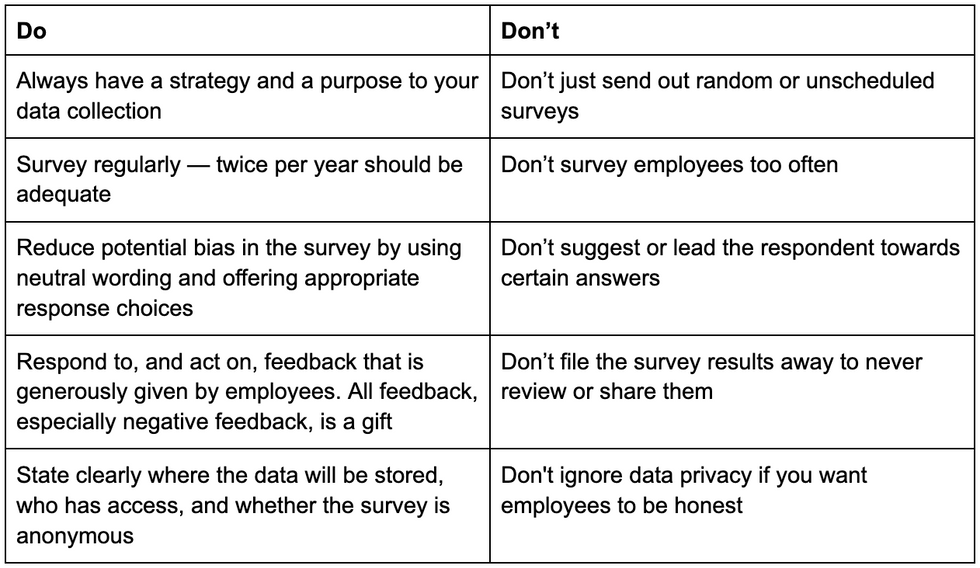Diversity and inclusion survey questions are tricky. To get at the information you’re looking for, they can’t be too long, too numerous, too specific, too vague, or too repetitive. You need to create that Goldilocks-style “just right” kind of survey. Diversity and inclusion survey questions also need to be rooted in a larger data collection strategy that informs why, how, and how often you survey your employees. Too often, and responses drop off. Too infrequent and your data doesn’t reflect a proper sample.
Above all, you want to get at the heart of if and how your Diversity, Equity, Inclusion, and Belonging (DEIB) efforts are having an impact. Bear in mind that every organization’s environment is unique. Today, we’ll share sample diversity survey questions that work. Remember, modifications should be made as appropriate. To make things easy, we’ve also included a diversity and inclusion survey template to power your survey efforts from start-to-finish. Ready to get started?
Demographics
Diversity and inclusion engagement survey questions should begin with demographics. You want to correlate opinions with certain demographics. This provides insight about employees’ needs. Below, you’ll find basic demographic questions with response options. Consult with your organization’s Employee Resource Groups for the proper options and wording in your region of the world, and follow inclusive language best practices throughout.
1. What best describes your race or ethnic identity? Choose all that apply:
Black/African-American, African, Middle East North African, Multiracial, South Asian, East Asian, Southeast Asian, Pacific Islander, Central Asian, Latinx, Afro-Caribbean, White, decline to state, prefer to self-describe (use open field)
2. What best describes your gender identity? Choose all that apply:
Woman, man, transgender, non-binary/gender non-conforming, Two-Spirit, agender, decline to state, prefer to self-describe (use open field)
3. What best describes your sexual orientation?
Queer, straight, lesbian, gay, bisexual, pansexual, asexual, decline to state, prefer to self-describe (use open field)
4. I identify as having a disability (cognitive, intellectual, or physical) or other chronic condition.
Yes, no, decline to state, prefer to self-describe (use open field)
5. I identify as neurodivergent.
Yes, no, decline to state, prefer to self-describe (use open field)
6. What is your caregiver status?
I am a primary caregiver, I am not a primary caregiver, decline to state, prefer to self-describe (use open field)
7. What is your veteran status?
I am a veteran, I am not a veteran, decline to state
8. What best describes your role at the company?
Employee, coordinator, team leader, manager, supervisor, director, executive, etc
9. What is your age?
16-26, 27-40, 41-58, 59+, decline to state
10. How long have you worked for the organization?
Less than 1 year, 1-2 years, 2-5 years, 5-10 years, 10+ years
11. Are there any other self-identifiers you use that we did not include above? Feel free to share.
(Optional open field)
Employee sentiment
Diversity and inclusion survey questions should focus on how your employees are perceiving the reality of DEIB at your organization as well as the company’s efforts towards achieving it.
Importance of DEIB efforts
12. Diversity, equity, inclusion, and belonging is ____________ to me at work.
- Very important
- Somewhat important
- Not important
13. Rank the importance of these DEIB policies and programs from 1 (most important) to 7 (least important):
- Policies ensuring fair hiring, pay, and promotions
- Trainings on DEIB
- Specific staff who are responsible for managing DEIB
- Salary transparency or a way to see pay ranges for all positions
- ERGs or affinity groups
- Paid volunteer time
- Charitable giving from the company
Employee perceptions towards DEIB
To make the survey as easy as possible for the respondent, group these questions together on the same 5-point Likert Scale with values such as:
- 1- strongly disagree, 3 - neither agree nor disagree, 5 - strongly agree
Diversity
14. I work on a diverse team.
15. This company values people of all different identities and backgrounds and recognizes everyone’s ideas.
16. People of all backgrounds and identities are respected in the organization.
17. Management consistently demonstrates through its actions that diversity is important.
Inclusion
18. My opinion is valued by leadership.
19. I am included in decisions that affect the organization.
20. I feel supported by my supervisor.
21. I feel supported by my team.
22. Getting to know coworkers from different backgrounds and identities has been easy.
Equity
23. I am treated fairly by my supervisor(s).
24. People of all backgrounds and identities are treated fairly at this organization.
25. I can freely share issues with my supervisor(s).
26. I have equal access to growth opportunities in the organization.
Belonging
27. I feel free to express my authentic self at work.
28. I am accepted exactly the way I am.
29. Racial, ethnic, sexual or gender-based “jokes” are not tolerated.
30. I feel safe at work.
31. I feel comfortable interacting with everyone on my team.
32. I trust my team.
Company efforts towards diversity, equity, inclusion, and belonging
33. I am aware of what the company’s diversity, equity, inclusion, and belonging policies are.
34. The organization’s policies towards diversity, equity, inclusion, and belonging are sufficient.
35. I have access to training and education regarding diversity, equity, inclusion, and belonging.
36. The available diversity, equity, inclusion, and belonging training is effective.
37. The hiring and recruitment team is diverse.
38. I am aware of policies and procedures to report discrimination.
39. The company takes appropriate action to address discrimination or bias.
40. Managers openly discuss diversity, equity, inclusion, and belonging with employees.
Open employee feedback
Your diversity questionnaire is not complete without providing space for open feedback. Allow long answer fields for the following questions, noting that all answers are optional.
41. What barriers do you face here in achieving your full potential?
42. How have you experienced exclusion in the workplace?
43. What can the organization do to improve diversity, equity, inclusion, and belonging for you?
Managers and leadership
Managers and leadership should answer the same diversity and inclusion survey questions above. They have valuable added insight about how DEIB is experienced in their roles. Add these additional questions when “manager” level is indicated in the demographics section.
Use the same 5-point Likert Scale with values such as:
- 1- strongly disagree, 3 - neither agree nor disagree, 5 - strongly agree
44. I understand what diversity, equity, inclusion, and belonging is.
45. As a manager, I clearly understand my role within diversity, equity, inclusion, and belonging policies.
46. I have the support and resources I need to promote diversity, equity, inclusion, and belonging.
47. The recruitment process provides qualified and diverse candidates for open positions.
48. I openly discuss diversity, equity, inclusion, and belonging within my team.
Allow open-field, long-answer responses for these questions:
49. What resources or support do you need to promote diversity, equity, inclusion, and belonging on your team?
50. How have diversity, equity, inclusion, and belonging impacted your team?
Do’s, don'ts, and data analysis. Oh my!
Sending out diversity, equity, and inclusion survey questions should be a regular occurrence. To ensure future engagement with the survey, follow these best practices:
Data analysis
If statistics are not your strong suit, then your survey software should have some auto-generated reports and charts for you. To get the most out of your DEIB data, you should consult with someone on your business team who is responsible for data analysis. Do this before surveying when you’re structuring your DEIB survey questions as well as afterward when you’re analyzing the data.
Diversity and inclusion survey questions are not one-size-fits-all
Asking the right diversity and inclusion survey questions is all about context. There is no one-size-fits-all DEIB survey. Each organization is as unique as the people who bring it to life. While these diversity and inclusion survey questions are a good template, go the extra step to make it right for your teams. Talk to your ERGs about demographic questions. Bring your data analyst onboard to help structure the survey. Always have a strategic plan for your data, and be transparent about how results will be communicated company-wide.




